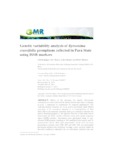Por favor, use este identificador para citar o enlazar este ítem:
http://www.alice.cnptia.embrapa.br/alice/handle/doc/1057399Registro completo de metadatos
| Campo DC | Valor | Lengua/Idioma |
|---|---|---|
| dc.contributor.author | RODRIGUES, S. M. | pt_BR |
| dc.contributor.author | MOURA, E. F. | pt_BR |
| dc.contributor.author | RAMOS, G. K. S. | pt_BR |
| dc.contributor.author | OLIVEIRA, M. S. P. | pt_BR |
| dc.date.accessioned | 2016-11-29T11:11:11Z | pt_BR |
| dc.date.available | 2016-11-29T11:11:11Z | pt_BR |
| dc.date.created | 2016-11-29 | pt_BR |
| dc.date.issued | 2016 | pt_BR |
| dc.identifier.citation | Genetics and Molecular Research, v. 15, n. 4, article gmr15048887, 2016. | pt_BR |
| dc.identifier.uri | http://www.alice.cnptia.embrapa.br/alice/handle/doc/1057399 | pt_BR |
| dc.description | Native of the Amazon, the nanche (Byrsonima crassifolia) is a fruit cultivated by family farmers and used in cooking; as such, it represents an opportunity for regional agribusiness. The Embrapa Eastern Amazon set up an active germplasm bank (BAG) consisting of 22 accessions sampled in 11 municipalities of Pará State. Due to its economic potential, there is an interest to advance the genetic breeding program of this species. The aim of this study was to characterize the BAG nanche collection using inter-simple sequence repeat (ISSR) markers. Accessions were genotyped using 23 pre-selected ISSR primers resulting in 109 amplified polymorphic and 51 monomorphic bands. With eight polymorphic bands each, the most polymorphic primers were UBC 809 and UBC 848. An unweighted pair-group method with arithmetic average cluster analysis based on Jaccard?s coefficient indicated that the individuals clustered into two distinct groups. Accessions Igarapé Açu-2 and Augusto Corrêa-Pl 1 were most similar. The genetic dissimilarity values ranged from 0.10 to 0.59. We conclude that the ISSR markers were efficient in detecting polymorphisms in the nanche accessions, and that it is possible to infer the genetic variability among accessions of the collection. This demonstrate the importance of using molecular markers in poorly studied species and the advantages that this information can bring to the genetic improvement of such species. | pt_BR |
| dc.language.iso | eng | eng |
| dc.rights | openAccess | eng |
| dc.title | Genetic variability analysis of Byrsonima crassifolia germplasm collected in Pará State using ISSR markers. | pt_BR |
| dc.type | Artigo de periódico | pt_BR |
| dc.date.updated | 2016-11-29T11:11:11Z | pt_BR |
| dc.subject.thesagro | Marcador Molecular | pt_BR |
| dc.subject.thesagro | Murici | pt_BR |
| dc.subject.nalthesaurus | Malpighiaceae | pt_BR |
| riaa.ainfo.id | 1057399 | pt_BR |
| riaa.ainfo.lastupdate | 2016-11-29 | pt_BR |
| dc.identifier.doi | 10.4238/gmr15048887 | pt_BR |
| dc.contributor.institution | SIMONE DE MIRANDA RODRIGUES, CPATU; ELISA FERREIRA MOURA CUNHA, CPATU; G. K. S. Ramos, UFRA; MARIA DO SOCORRO P DE OLIVEIRA, CPATU. | pt_BR |
| Aparece en las colecciones: | Artigo em periódico indexado (CPATU)  | |
Ficheros en este ítem:
| Fichero | Descripción | Tamaño | Formato | |
|---|---|---|---|---|
| gmr8887Muruci2016.pdf | 756.24 kB | Adobe PDF |  Visualizar/Abrir |









